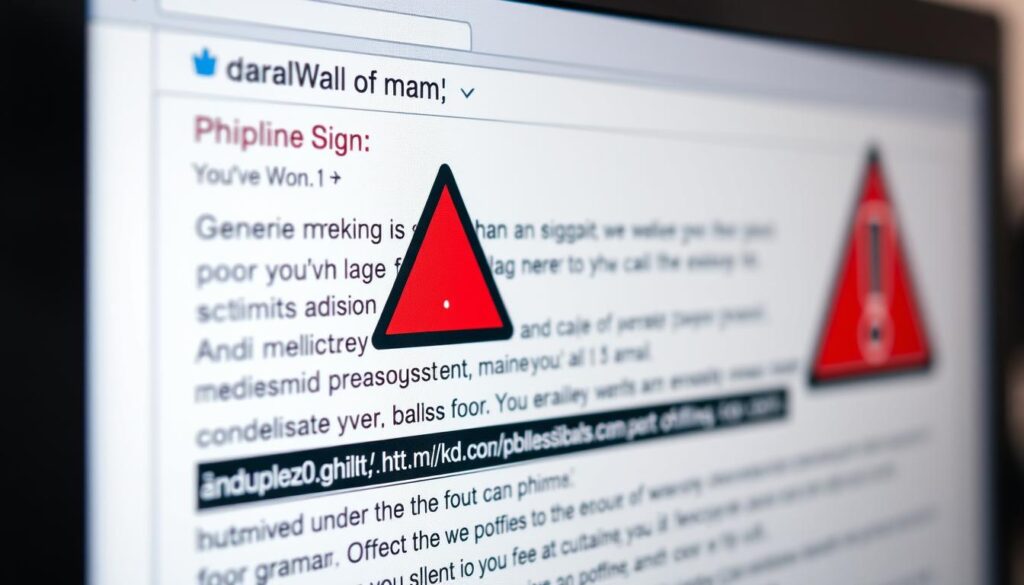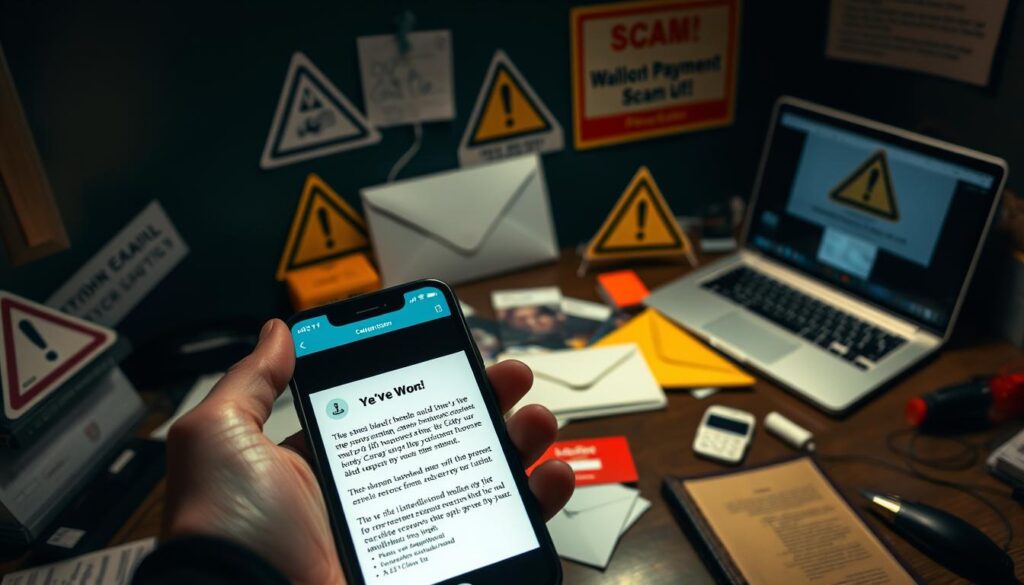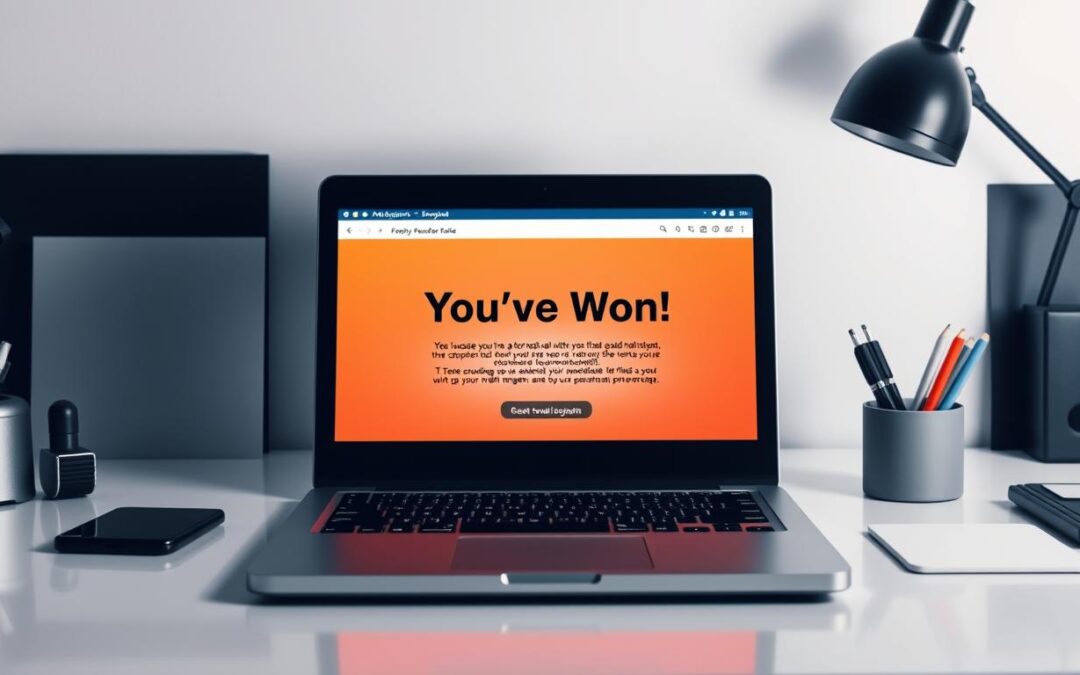Unexpected prize notifications often trigger excitement—but they can also hide dangerous traps. Cybercriminals craft fraudulent emails claiming you’ve won cash, vacations, or luxury items to manipulate emotions and extract sensitive data. These messages frequently demand upfront payments for taxes, fees, or shipping costs, creating artificial urgency to bypass rational thinking.
Legitimate contests never require winners to pay to claim rewards. Reputable organizations absorb all associated costs, and authentic notifications include verifiable contact details. Scammers, however, pressure recipients to act quickly through threats of prize forfeiture or limited-time offers. Payment requests via gift cards, cryptocurrency, or wire transfers are immediate red flags.
Phishing attempts often mimic trusted brands with professional-looking logos and email templates. Yet subtle errors—like mismatched sender addresses or generic greetings—reveal their true nature. Always cross-check claims through official websites or customer service channels before responding.
Key Takeaways
- Genuine contests never ask for payments to receive prizes
- Urgent demands for personal or financial data signal scams
- Verify unexpected winnings through official company channels
- Check sender addresses and look for spelling inconsistencies
- Avoid sharing sensitive information in response to unsolicited emails
Understanding the World of Lottery and Sweepstakes Scams
Modern fraudsters craft messages that mirror real contests to deceive recipients. These phishing emails blend professional design with psychological triggers, making them harder to distinguish from authentic communications. While genuine organizations use clear terms, scammers rely on urgency and too-good-to-be-true offers.
What Makes a Scam Email Look Genuine?
Fraudulent messages often mimic legitimate communications through branded templates and polished language. Scammers replicate official logos, use realistic email addresses, and reference fake contest entry details. Below are key differences between authentic and deceptive notifications:
| Feature | Legitimate Email | Scam Email |
|---|---|---|
| Sender Address | @companydomain.com | @freemailprovider.net |
| Prize Details | Specific contest name | Vague "international lottery" |
| Contact Info | Verified phone/address | Generic support@ email |
| Payment Requests | None | Taxes or "processing fees" |
The Psychology Behind the Promise of a Prize
Scammers exploit basic human desires for financial freedom and instant gratification. The sudden announcement of unclaimed winnings triggers emotional responses that override logical thinking. This tactic works because:
- Unexpected windfalls create temporary euphoria
- Time-sensitive demands limit fact-checking
- Familiar brand impersonations build false trust
Legitimate prize notifications always provide verification methods through official channels. Authentic contests never require payments or sensitive data to claim rewards.
Why Scammers Tempt You with Prizes
The promise of instant wealth triggers powerful psychological reactions that criminals exploit. Scammers strategically offer vacations, cash windfalls, or luxury items because these rewards bypass logical evaluation. Their success lies in targeting deep-seated desires for financial security and memorable experiences.
The Lure of Free Money and Vacations
Fraudulent prize offers work because they mirror genuine aspirations. Consider these psychological triggers criminals use:
| Scammer Tactics | Human Psychology |
|---|---|
| Too-good-to-be-true offers | Desire for financial freedom |
| Limited-time claims | Fear of missing opportunities |
| "Exclusive" selection | Need for social validation |
| Requests for small fees | Sunken cost fallacy |
Legitimate organizations never require payments to release prizes. Yet phishing emails often demand "processing fees" or sensitive data under the guise of verification. This shift from excitement to obligation catches many off guard.
Three factors make these schemes effective:
- Universal appeal across age and income groups
- Emotional engagement overriding critical thinking
- Professional-looking templates mimicking real contests
Recognizing authentic prizes becomes easier when you remember: real winners aren’t asked for credit card details or wire transfers. Always verify through official channels before responding to unexpected email notifications.
How to Spot Fake "You've Won!" Emails
Fraudulent prize announcements prey on human psychology through carefully engineered urgency. Cybercriminals design these phishing emails to bypass logical evaluation by combining professional layouts with manipulative language patterns.
Critical Warning Signs in Message Content
Genuine organizations never demand immediate action. Watch for these indicators of suspicious email communications:
- Countdown timers or "act now" ultimatums
- Requests for Social Security numbers or bank details
- Mismatched sender addresses disguised as trusted brands
- Generic greetings like "Dear Winner" instead of your name
Scammer Strategies Revealed
Criminals employ predictable methods to bypass security measures. Three prevalent techniques include:
- Fabricated competition histories ("You entered our July draw!")
- Payment demands masked as "verification fees"
- Fake authority claims ("Approved by US Contest Bureau")
Legitimate organizations provide detailed participation records and official documentation. As one cybersecurity expert notes:
"Authentic prize notifications arrive without strings attached—no reputable company asks winners to pay to receive rewards."
Always cross-reference unexpected winnings through official websites or verified phone numbers. Remember: scammers often collapse the timeline between excitement and obligation to prevent rational verification.
Recognizing Phishing Scams and Suspicious Email Traits
Digital deception often reveals itself through careless mistakes. Cybercriminals send phishing emails disguised as prize alerts, but linguistic flaws and visual inconsistencies expose their true nature. Professional organizations maintain strict quality control, making errors rare in authentic communications.

Spotting Grammatical and Formatting Errors
Fraudulent messages frequently contain multiple red flags. Compare these characteristics of phishing scams versus legitimate correspondence:
| Feature | Phishing Email | Authentic Message |
|---|---|---|
| Language Quality | Misspelled words, awkward phrasing | Polished, professional tone |
| Branding | Blurry logos, color mismatches | High-resolution official graphics |
| Sender Address | gmail123@service.net | support@companydomain.com |
| Greeting | "Dear Customer" or "Valued Winner" | Personalized with your name |
Urgent demands like "Claim within 24 hours!" appear in 78% of phishing scams according to FTC data. Legitimate companies provide reasonable response windows. Always check email headers for mismatched domains - a key indicator of deception.
Three verification steps protect against fraud:
- Hover over links to preview actual URLs
- Contact organizations through official channels
- Compare email formatting with previous correspondence
Remember: Grammatical errors and rushed formatting often indicate phishing attempts. Trustworthy institutions prioritize clear communication and brand consistency.
Protecting Your Personal and Financial Information
Guarding sensitive data requires proactive measures and informed decision-making. Scammers frequently target personal information through elaborate schemes, making vigilance your first line of defense. Establish clear boundaries for sharing details, even when requests appear legitimate.
Best Practices to Secure Sensitive Data
Reputable institutions follow strict protocols for handling financial information. Never disclose account numbers, passwords, or Social Security details through unsolicited communications. As cybersecurity expert Linda Pearson advises:
"Legitimate organizations process prize claims through secure portals—not email attachments or phone calls demanding immediate action."
Three essential security measures:
- Verify requests through official company websites or customer service lines
- Enable two-factor authentication for critical accounts
- Monitor bank statements for unauthorized transactions
Steps to Prevent Identity Theft
Criminals exploit account details to create fake identities or drain existing resources. Protect yourself by:
| Secure Action | Risky Behavior |
|---|---|
| Using encrypted password managers | Sharing login credentials via email |
| Freezing credit reports annually | Storing sensitive data in email drafts |
| Reviewing privacy settings monthly | Clicking "verify account" links in prize notifications |
Remember: Authentic prize distributors never ask for upfront payments or bank account access. When in doubt, contact financial institutions directly using verified contact information from official sources.
Identifying Common Payment Scams: Cash, Gift Cards, and More
Fraudulent prize claims often pivot from excitement to financial demands within moments. Scammers strategically request payments through methods that leave victims powerless to recover funds. Understanding these tactics helps protect your bank account and personal assets.

Why Requesting Payment is a Major Warning Sign
Legitimate contests operate under strict regulations prohibiting upfront charges. When scammers demand money for taxes or processing fees, they violate sweepstakes laws. These requests often escalate from small "verification fees" to larger financial drains.
| Scam Tactic | Purpose | Legitimate Alternative |
|---|---|---|
| Gift card payments | Untraceable transfers | No payment required |
| Credit card "verification" | Steal card details | Direct deposit from organizer |
| Bank account requests | Unauthorized withdrawals | Secure prize claim portal |
Cybersecurity analyst Mark Tabor notes:
"Authentic prize services never mix celebration with financial obligations. Winners receive funds through certified checks or electronic transfers—never reverse charges."
Three critical patterns expose payment scams:
- Requests for cryptocurrency or wire transfers
- Pressure to share financial information immediately
- Claims of "government fees" requiring personal payment
Protect your bank and credit accounts by remembering: real prizes arrive without strings. Report any payment demands to consumer protection agencies.
Verifying Contest Legitimacy and Sweepstakes Practices
Authentic contests maintain transparent operations that prioritize participant rights and legal compliance. Federal regulations require organizers to disclose entry methods, prize values, and selection processes upfront. This transparency separates genuine opportunities from deceptive schemes.
Core Principles of Trustworthy Promotions
Legally compliant contests operate under three non-negotiable rules:
- No purchase requirements for entry or prize claims
- Clear documentation of odds and redemption procedures
- Verifiable contact details matching official domains
Reputable organizations provide physical addresses, toll-free phone numbers, and email addresses ending with company domains. For example, legitimate notifications from "Global Sweeps Inc." would use @globalsweeps.com rather than generic email services.
| Legitimate Practice | Scam Indicator |
|---|---|
| Winner notifications via certified mail | Unsolicited prize emails with payment demands |
| Publicly listed customer service hours | 24/7 "urgent response" chat boxes |
| Official rules published before entry | Vague references to "international contest laws" |
"Genuine sweepstakes never require winners to pay fees—those costs fall on sponsors by law," notes consumer protection attorney Rachel Nguyen.
Always cross-check details through multiple channels. Contact organizers using phone numbers from official websites rather than those provided in unsolicited communications. Authentic services welcome verification attempts and provide documented proof of contest legitimacy.
Reporting Scam Activities and Informing Trusted Contacts
Taking action against fraudulent schemes protects both individuals and communities. When encountering suspicious prize claims, immediate reporting strengthens legal responses and prevents further exploitation.
Effective Channels for Fraud Reporting
The Federal Trade Commission (FTC) leads national efforts to combat consumer fraud. Visit reportfraud.ftc.gov or call 1-877-FTC-HELP to file detailed reports. These submissions help authorities identify patterns and dismantle criminal networks.
Law enforcement agencies use FTC data to track scam operations globally. Specialists analyze reports to freeze fraudulent accounts and recover stolen funds. Always document these details when reporting:
- Sender email addresses and message content
- Specific payment demands or fake contest rules
- Dates and times of suspicious communications
Share experiences with trusted contacts to build collective awareness. Many victims avoid falling victim after learning from others’ encounters. The FTC’s Consumer Alerts portal provides real-time updates on emerging threats.
Remember: Scammers often reuse tactics across multiple targets. Forward phishing attempts to reportphishing@apwg.org while alerting the FTC. Quick action limits damage and protects vulnerable groups from financial harm.
